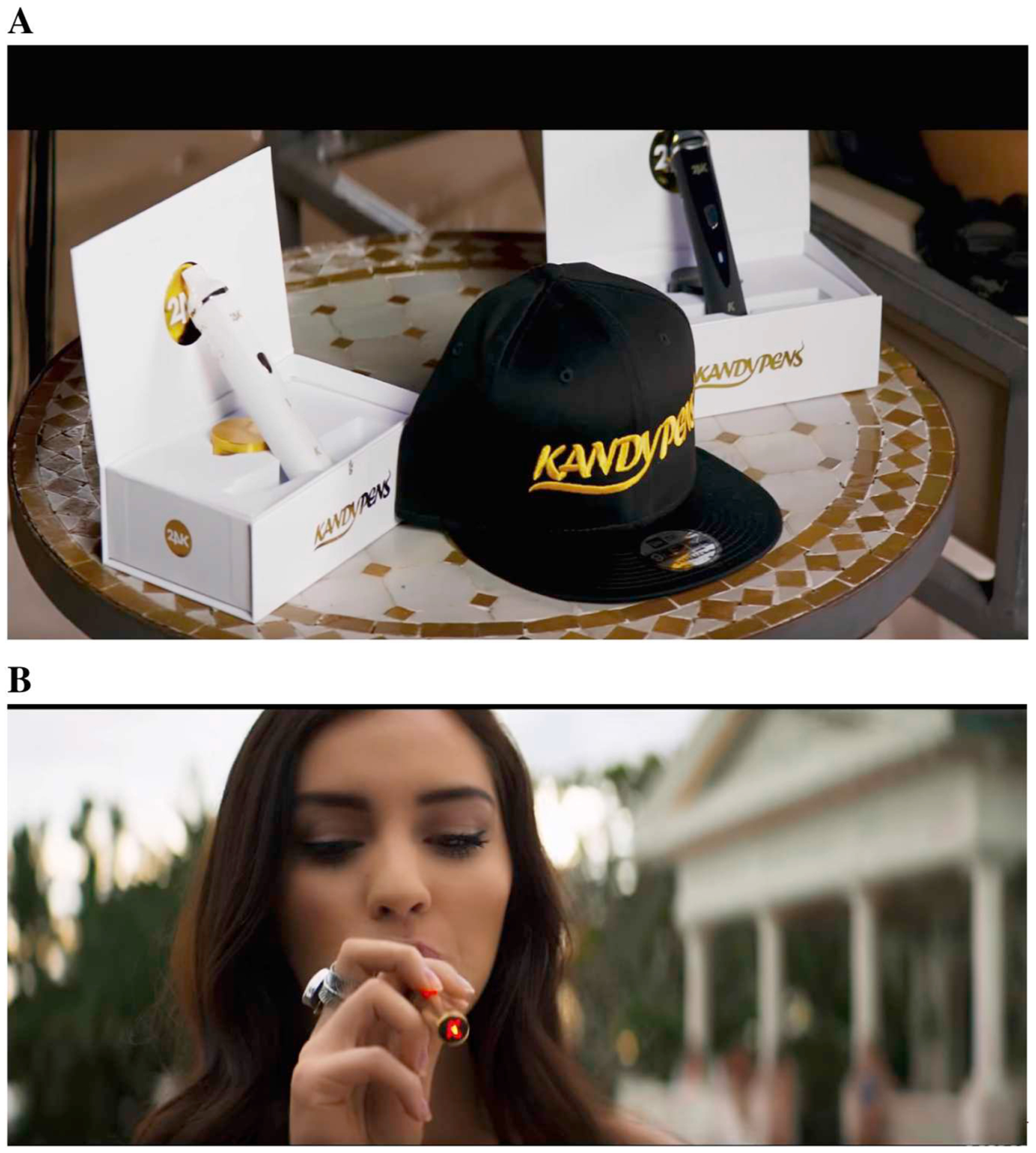During the course of our ongoing research on tobacco marketing and promotions, we witnessed a vape pen company, KandyPens, place their products in popular music videos. For example, KandyPens were in a recent music video for the song “I’m the one” by artist DJ Khaled that featured Justin Bieber. In the music video, KandyPens products are shown being used by bikini-clad women as they partake in a party on the grounds of an opulent home overlooking the Pacific Ocean. Fig. 1 provides examples of the many close-ups KandyPens’ products receive throughout the music video (please see supplementary material for additional images of product placement).
Fig. 1.

A and B shows KandyPens product placement in the music video “I’m the one” by artist DJ Khaled featuring Justin Bieber.
We identified all music videos promoted by KandyPens on their brand website (www.kandypens.com), and Instagram account, and recorded views on YouTube for each official music video to estimate marketing exposure. KandyPens have appeared in 29 music videos dating back to June 15, 2015. Combining the views of these 29 music videos on YouTube, KandyPens’ products have been viewed over 1.4 billion times in 24 months. This does not account for views on television or other streaming services so the total marketing exposure is even greater. While this initial data alone cannot determine that viewers were young adults or adolescents, prior research has described YouTube as one of “the most youth-oriented websites in the United States,” (Kim, Paek, & Lynn, 2010) requiring further investigation.
Vape pen product placement in music videos is not commonly identified in measures of tobacco marketing exposure. In a recent study published in Addictive Behaviors, Hébert and colleagues developed an updated measurement of tobacco marketing exposure using an ecological momentary assessment (EMA) design (Hébert et al., n.d.). They asked participants to report on both industry-sponsored marketing (defined as printed ads, flyers, billboards, coupons or promotional-email offers, online ads, and industry-sponsored social media such as an official Facebook page), and user-generated messages (defined as Facebook posts, Instagram photos, Vines, or Tweets, and online discussion threads) (Hébert et al., n.d.). However, they omitted asking participants about product placement in popular music videos that are aimed at their study’s target population (young adults) and other vulnerable populations (adolescents).
Researchers focused on documenting tobacco-marketing strategies should determine the extent of vaping product placement in popular music videos and examine the associations between levels of exposure to these marketing strategies and tobacco-attitudes and behaviors. Researchers could identify and record the names of popular music videos that contain vape pen product placement and ask participants if they have seen such videos. Prior research has used similar strategies to measure adolescents’ exposure to smoking imagery in music videos (Cranwell et al., 2015). Additionally, researchers should examine the causal impact of these marketing strategies on product appeal in adolescents and young adults.
The sheer volume of music video views and the ability of other vape pen companies to adopt this marketing strategy warrant attention by the greater tobacco control community. In the United States, the 1999 Master Settlement Agreement placed restrictions on the types of cigarette and smokeless (chew) tobacco advertising and marketing strategies that appeal to youth such as advertisements on billboards and in youth magazines, use of cartoons for major cigarette and smokeless tobacco brands, and paid product placement in television and motion pictures (National Association of Attorneys General, 2000). However, the Master Settlement Agreement does not restrict new products such as vaping devices.
Product placement in popular music videos should be continually monitored and assessed to inform developing policies on vaping marketing restrictions and developing prevention messages tailored for youth. Given the diffusion of media promotions online (Chu et al., 2015), vape pen companies like KandyPens can reach a large audience quickly and inexpensively to communicate its brand’s message. Music videos promoting KandyPens provide positive messages about vaping products without health warnings or age restrictions and may warrant counter messaging. Tobacco control programmers should document and measure all marketing strategies by vape pen companies in their pursuit to fully describe tobacco-marketing exposure. This research can inform regulations aimed at curbing vape pen product placement in music videos in the United States and elsewhere.
Supplementary Material
Role of funding source
Research reported in this publication was supported by Grant # P50CA180905 from the National Cancer Institute and the FDA Center for Tobacco Products (CTP). The NIH or FDA had no role in study design, collection, analysis, and interpretation of data, writing the report, and the decision to submit the report for publication. The content is solely the responsibility of the authors and does not necessarily represent the official views of the NIH or FDA.
Footnotes
Conflicts of interest
The authors declare no conflicts of interest.
Supplementary data to this article can be found online at https://doi.org/10.1016/j.addbeh.2017.10.027.
References
- Chu KH, Unger JB, Allem JP, Pattarroyo M, Soto DW, Cruz TB, … Yang CC (2015). Diffusion of messages from an electronic cigarette brand to potential users through twitter. PLoS One, 10(12), e0145387. [DOI] [PMC free article] [PubMed] [Google Scholar]
- Cranwell J, Murray R, Lewis S, Leonardi-Bee J, Dockrell M, & Britton J (2015). Adolescents’ exposure to tobacco and alcohol content in YouTube music videos. Addiction, 110(4), 703–711. [DOI] [PMC free article] [PubMed] [Google Scholar]
- Hébert ET, Vandewater EA, Businelle MS, Harrell MB, Kelder SH, & Perry CL (2017). Feasibility and reliability of a mobile tool to evaluate exposure to tobacco product marketing and messages using ecological momentary assessment. Addict. Behav Epub ahead of print. May 3. [DOI] [PMC free article] [PubMed] [Google Scholar]
- Kim K, Paek HJ, & Lynn J (2010). A content analysis of smoking fetish videos on YouTube: regulatory implications for tobacco control. Health Commun. 25(2), 97–106. [DOI] [PubMed] [Google Scholar]
- National Association of Attorneys General (2000). Tobacco. Retrieved from http://www.naag.org/tobacco.php.
Associated Data
This section collects any data citations, data availability statements, or supplementary materials included in this article.


